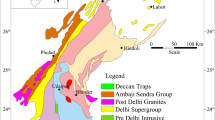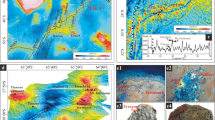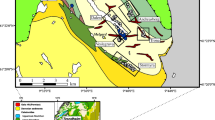Abstract
Polymetallic sulfides from two hydrothermal chimneys and talus deposit from the Vienna Woods field of Manus Basin were studied for mineralogy, elemental composition, and S-isotope ratio to understand their evolution. The factors including the nature of source fluid, mineral paragenesis, and related geochemical processes have been discussed. Mineralogy and elemental concentration of Cu and Fe-rich large chimney at the central part of this hydrothermal field was completely different from the smaller Zn-rich peripheral chimney and Fe-rich talus deposit, suggesting the variable degree of alterations generate physico-chemically different source fluids responsible for these hydrothermal structures. Similarly, S-isotope ratios also indicate chemically diverse fluids and different modes of precipitation were involved in their evolution. Distinct mineral zonings and associated elemental and isotopic compositions within individual deposit confirm paragenetic shifts were involved during their growth process.
Similar content being viewed by others
References
Alt J C, Lonsdale P, Haymon R, et al. 1987. Hydrothermal sulfide and oxide deposits on seamounts near 21°N, East Pacific Rise. GSA Bull, 98(2): 157–168
Auzende J M, Ishibashi J I, Beaudoin Y, et al. 2000. Extensive magmatic and hydrothermal activity documented in Manus Basin. Eos, Transactions American Geophysical Union, 81(39): 449–453
Auzende J M, Urabe T, Scientific Party. 1996. Cruise explores hydrothermal vents of the Manus Basin. Eos, Transactions American Geophysical Union, 77(26): 244
Balaram V, Rao TG. 2003. Rapid determination of REEs and other trace elements in geological samples by microwave acid digestion and ICP-MS. Atom Spectrosc, 24(6): 206–212
Binns R A, Scott S D. 1993. Actively forming polymetallic sulfide deposits associated with felsic volcanic rocks in the eastern Manus back-arc Basin, Papua New Guinea. Econ Geol, 88(8): 2226–2236
Both R, Crook K, Taylor B, et al. 1986. Hydrothermal chimneys and associated fauna in the Manus back-arc basin, Papua New Guinea. Eos, Transactions American Geophysical Union, 67(21): 489–490
Coplen T B, Krouse H R. 1998. Sulphur isotope data consistency improved. Nature, 392(6671): 32
Crook K A W. 1990. Preliminary Report of the 21st RV Akademik Mstislav Keldysh/ Mir Cruise 1990, Manus Basin Leg (21st May–7th June), on behalf of the Keldysh/Mir Science Team, SOPAC Cruise Report 127, 22
Dekov V M, Rouxel O, Kouzmanov K, et al. 2016. Enargite-luzonite hydrothermal vents in Manus Back-Arc Basin: submarine analogues of high-sulfidation epithermal mineralization. Chem Geol, 438: 36–57
Fouquet Y, Von Stackelberg U, Charlou J L, et al. 1991. Hydrothermal activity and metallogenesis in the Lau back-arc basin. Nature, 349(6312): 778–781
Gena K. 2013. Deleterious elements associated with submarine hydrothermal deposits in Manus basin, Papua New Guinea. In: Proceedings of 7th HUON Seminar on Achieving Vision 2050 Through Higher Education, Research, Science & Technology. Lae, Papua New Guinea: Papua New Guinea University of Technology, 73–80
Goldfarb M S, Converse D R, Holland H D, et al. 1983. The genesis of hot spring deposits on the East Pacific Rise, 21°N. In: Ohmoto H, Skinner B J, eds. The Kuroko and Related Volcanogenic Massive Sulfide Deposits, Economic Geology Monograph, Volume 5. New Haven, Conn: Economic Geology Publication, 184–197
Gena K, Chiba H, Kase K, et al. 2013. The Tiger sulfide chimney, Yonaguni Knoll IV hydrothermal field, southern Okinawa Trough, Japan: The first reported occurrence of Pt-Cu-Fe-bearing bismuthinite and Sn-bearing chalcopyrite in an active seafloor hydrothermal system. Res Geol, 63(4): 360–370
Hannington M D, Scott S D. 1988. Mineralogy and geochemistry of a hydrothermal silica-sulfide-sulfate spire in the caldera of Axial seamount, Juan De Fuca Ridge. Can Mineral, 26(3): 603–625
Haymon R M. 1983. Growth history of hydrothermal black smoker chimneys. Nature, 301(5902): 695–698
Ishibashi J, Urabe T. 1995. Hydrothermal activity related to arc-backarc magmatism in the Western Pacific. In: Taylor B, ed. Backarc Basins. New York: Plenum, 451–495
Kawasumi S, Chiba H. 2017. Redox state of seafloor hydrothermal fluids and its effect on sulfide mineralization. Chem Geol, 451: 25–37
Kim J, Lee I, Lee K Y. 2004. S, Sr, and Pb isotopic systematics of hydrothermal chimney precipitates from the Eastern Manus Basin, western Pacific: Evaluation of magmatic contribution to hydrothermal system. J Geophys Res, 109(B12): B12210, doi: 10.1029/2003JB002912
Kojima S, Ohmoto H. 1991. Hydrothermal synthesis of wurtzite and sphalerite at T=350°C-250°C. Min Geol, 41(229): 313–327
Koski R A, Jonasson I R, Kadko D C, et al. 1994. Compositions, growth mechanisms, and temporal relations of hydrothermal sulfidesulfate-silica chimneys at the northern Cleft segment, Juan de Fuca Ridge. J Geophys Res, 99(B3): 4813–4832
Kristall B, Nielsen D, Hannington M D, et al. 2011. Chemical microenvironments within sulfide structures from the Mothra Hydrothermal field: Evidence from high-resolution zoning of trace elements. Chem Geol, 290(1-2): 12–30
Lein A Y, Ul’yanova N V, Grinenko V A, et al. 1993. Mineralogical and geochemical features of the Manus Basin hydrothermal sulfide ores, Bismarck Sea. Geochem Int, 30(11): 57–71
Lizitsyn A P, Crook K A W, Bogdanov Y A, et al. 1993. A hydrothermal field in the rift zone of the Manus Basin, Bismarck Sea. Int Geol Rev, 35(2): 105–126
Lisitzin A P, Lukashin V N, Gordeev V V, et al. 1997. Hydrological and geochemical anomalies associated with hydrothermal activity in SW Pacific marginal and back-arc basins. Mar Geol, 142(1-4): 7–45
Marchig V, Roesch H, Lalou C, et al. 1988. Mineralogical zonation and radiochronological relations in a large sulfide chimney from the East Pacific Rise at 18°25’S. Can Mineral, 26(3): 541–554
Martinez F, Taylor B. 1996. Backarc spreading, rifting, and microplate rotation, between transform faults in the Manus Basin. Mar Geophys Res, 18(2-4): 203–224
Mudholkar A V, Paropkari A L. 1999. Evolution of the basalts from three back-arc basins of southwest Pacific. Geo-Mar Lett, 18(4): 305–314
Murowchick J B, Barnes H L. 1986. Marcasite precipitation from hydrothermal solutions. Geochim Cosmochim Acta, 50(12): 2615–2629
Ohmoto H, Cole D R, Mottl M J. 1976. Experimental basalt-seawater interaction: sulfur and oxygen isotope studies. Eos, Transactions American Geophysical Union, 57: 342
Paradis S, Jonasson I R, Le Cheminant G M, et al. 1988. Two zinc-rich chimneys from the plume site, Southern Juan de Fuca Ridge. Can Mineral, 26(3): 637–654
Paropkari A L, Ray D, Balaram V, et al. 2010. Formation of hydrothermal deposits at Kings Triple Junction, northern Lau backarc basin, SW Pacific: the geochemical perspectives. J Asian Earth Sci, 38(3-4): 121–130
Ray D, Banerjee R, Balakrishnan S, et al. 2016. S-and Sr-isotopic compositions in barite-silica chimney from the Franklin seamount, Woodlark basin, Papua New Guinea: constraints on genesis and temporal variability of hydrothermal fluid. Int J Earth Sci, 106(5): 1723–1733
Ray D, Kota D, Das P, et al. 2014. Microtexture and distribution of minerals in hydrothermal barite-silica chimney from the Franklin Seamount, SW Pacific: constraints on mode of formation. Acta Geol Sin (Engl Ed), 88(1): 213–225
Rees C E, Jenkins W J, Monster J. 1978. The sulphur isotopic composition of ocean water sulphate. Geochim Cosmochim Acta, 42(4): 377–381
Reeves E P, Seewald J S, Saccocia P, et al. 2011. Geochemistry of hydrothermal fluids from the PACMANUS, Northeast Pual and Vienna Woods hydrothermal fields, Manus Basin, Papua New Guinea. Geochim Cosmochim Acta, 75(4): 1088–1123
Scott S D, Barnes H L. 1972. Sphalerite-wurtzite equilibria and stoichiometry. Geochim Cosmochim Acta, 36(11): 1275–1295
Scott S D, Chase R L, Barrett T J, et al. 1984. Tectonic framework and sulfide deposits of the Southern Explorer ridge, Northeastern Pacific Ocean. Eos, Transactions American Geophysical Union, 65: 1111
Sinton J. 1997. The Manus Spreading Center near 3°22'S and the Worm Garden hydrothermal site: results of Mir2 submersible dive 15. Mar Geol, 142(1-4): 207–209
Sinton J M, Ford L L, Chappell B, et al. 2003. Magma genesis and mantle heterogeneity in the Manus Backarc basin, Papua New Guinea. J Petrol, 44(1): 159–195
Smith W H F. 1993. On the accuracy of digital bathymetric data. J Geophys Res, 98(B6): 9591–9603
Styrt M M, Brackmann A J, Holland H D, et al. 1981. The mineralogy and the isotopic composition of sulfur in hydrothermal sulfide/sulfate deposits on the East Pacific Rise, 21°N latitude. Earth Planet Sci Lett, 53(3): 382–390
Tamaki K, Honza E. 1991. Global tectonics and formation of marginal basin: role of the western Pacific. Episodes, 14: 224–230
Tao C H, Li H M, Huang W et al. 2011. Mineralogical and geochemical features of sulfide chimneys from the 49°39’E hydrothermal field on the Southwest Indian Ridge and their geological inferences. Chin Sci Bull, 56(26): 2828–2838
Taylor B, Crook K, Sinton J. 1994. Extensional transform zone and oblique spreading centers. J Geophys Res, 99(B10): 19707–19718
Tivey M K. 1998. The formation of mineral deposits at Mid-ocean ridges. Oceanus, 41(2): 68–74
Tivey M K, Delaney J R. 1986. Growth of large sulfide structures on the Endeavour segment of the Juan de Fuca Ridge. Earth Planet Sci Lett, 77(3-4): 303–317
Tufar W. 1990. Modern hydrothermal activity, formation of complex massive sulfide deposits and associated vent communities in the Manus back-arc basin (Bismarck Sea, Papua New Guinea). Mitt Österr Geol Ges, 82: 183–210
Zeng Z G, Ma Y, Chen S, et al. 2017. Sulfur and lead isotopic compositions of massive sulfides from deep-sea hydrothermal systems: implications for ore genesis and fluid circulation. Ore Geol Rev, 87: 155–171
Zierenberg R A, Shank W C, Bischoff J F. 1984. Massive sulfide deposits at 21°N, East Pacific Rise: Chemical composition, stable isotopes, and phase equilibria. GSA Bull, 95(8): 922–929
Acknowledgments
The authors are thankful to the Director, CSIR-National Institute of Oceanography, Goa for his encouragement. Paropkari is highly grateful to the Chief Scientist Alexander P Lizitsyn for inviting him to participate in the cruises of R/V Akademik Mstislav Keldysh and providing the samples to undertake scientific investigations. Authors are grateful to Girish Prabhu and Arif Sardar for XRD and SEM-EDS analyses respectively. Thanks to Dash J K Pondicherry University for ICP-MS analysis. This paper benefited from the comments made by two anonymous reviewers. S. Mukhopadhyay acknowledges the financial support from DSTPURSE (Phase-II) of Jadavpur University.
Author information
Authors and Affiliations
Corresponding author
Additional information
Foundation item: The GEOSINK project funded by CSIR, India; the CSIR-NIO contribution No. 6111.
Rights and permissions
About this article
Cite this article
Ray, D., Banerjee, R., Mazumder, A. et al. Mineralogical and geochemical variation in hydrothermal sulfides from Vienna Woods field, Manus Basin, Papua New Guinea: constraints on their evolution. Acta Oceanol. Sin. 37, 22–33 (2018). https://doi.org/10.1007/s13131-018-1194-4
Received:
Accepted:
Published:
Issue Date:
DOI: https://doi.org/10.1007/s13131-018-1194-4




